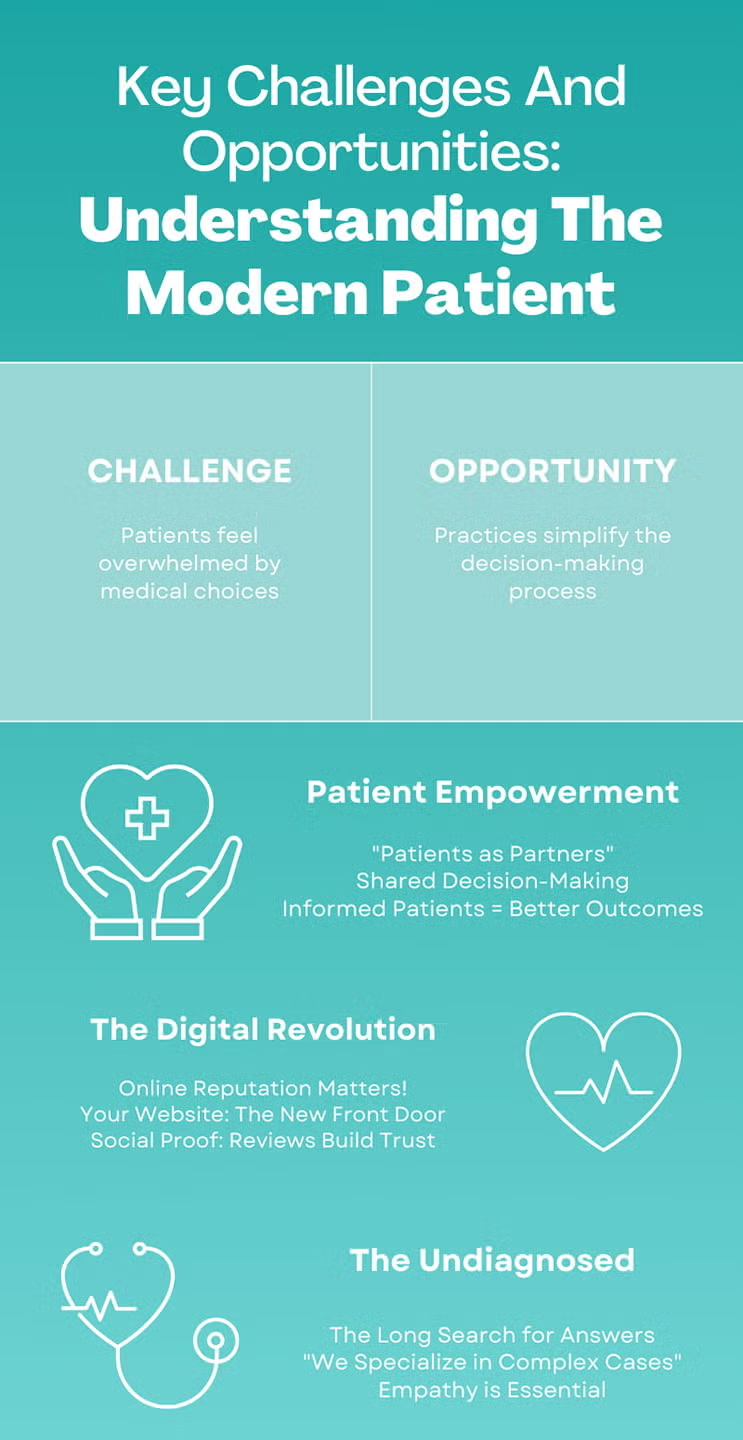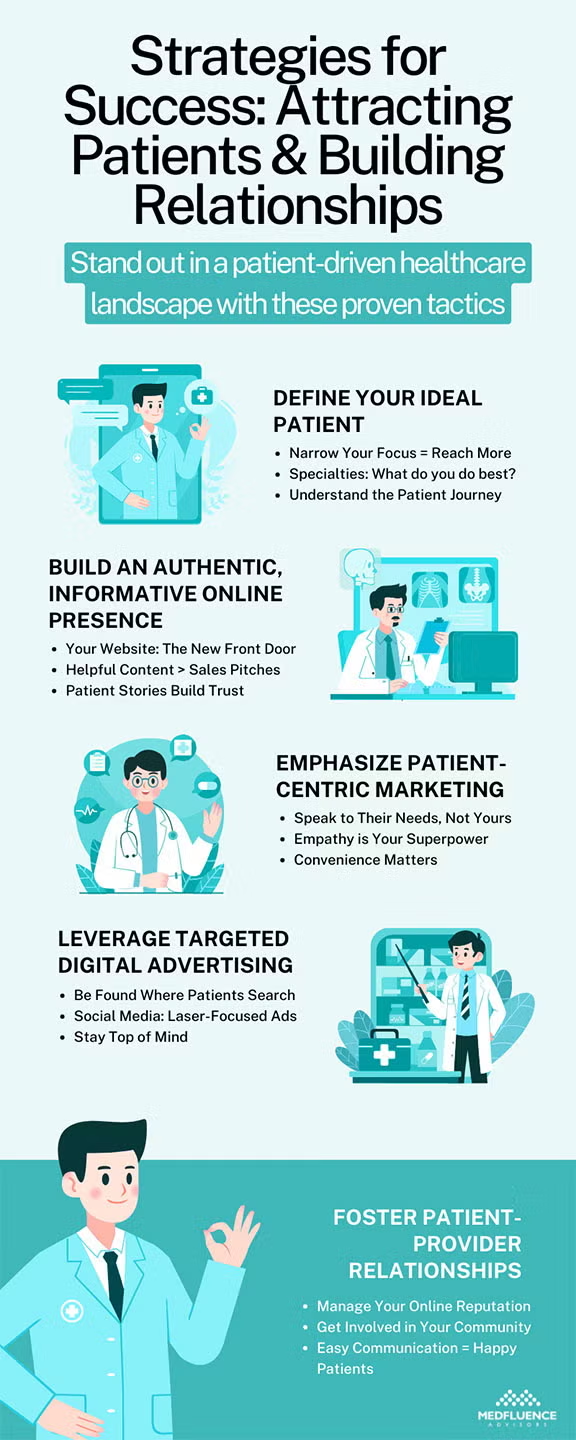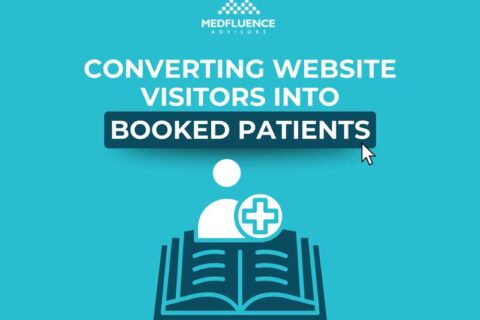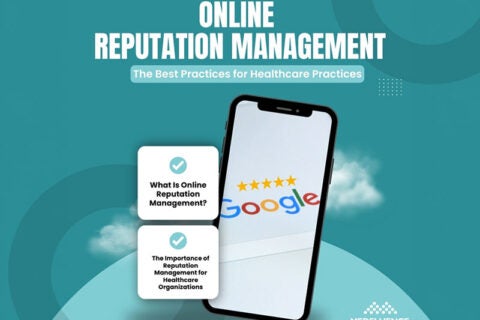The Essential Medical Marketing Guide: Connecting Patients And Providers In 2024
click here to receive a free
Digital Marketing Playbook

Imagine a busy mom struggling with chronic, undiagnosed pain. She bounced from one doctor to another, each appointment leaving her with a lingering sense of uncertainty. This mom feels frustrated, and hopeless, and worries that she’ll never find relief. Sadly, this story isn’t unique. Many patients grapple with undiagnosed or latent diseases, desperately seeking a provider who can pinpoint the problem and offer a path toward healing.
If your practice specializes in diagnosing and treating these complex cases, you know the profound difference you make in patients’ lives. But how do you connect with more patients? In today’s competitive marketing world, small and medium-sized private practices have a tough time finding new patients.
This guide is here to help you succeed. We’ve provided strategies that will speak to the hearts of your ideal patients, helping you connect with them on a level that says, “I get you.” Prepare to watch your practice flourish!
Key Challenges And Opportunities: Understanding The Modern Patient

click here to receive a free
Digital Marketing Playbook
Finding the right healthcare can be stressful, especially when dealing with complex medical issues. Let’s explore the key factors shaping today’s patient experience and how your practice can adapt:
Patient Empowerment
Today’s patients aren’t passive recipients of care. They’re armed with information (thanks to the internet) and expect a collaborative approach. Think of this as an opportunity! Practices that embrace patient education and shared decision-making build stronger, more trusting relationships.

click here to receive a free
Digital Marketing Playbook
The Challenge: Patients may arrive with information that is inaccurate, incomplete, or overwhelming. Providers need to skillfully navigate these situations, validating patient concerns while guiding them towards reliable medical information.
The Opportunity: Practices that embrace patient education and shared decision-making build stronger, more trusting relationships. Here’s how to create an empowering environment:
- Open Communication: Encourage questions and clearly explain treatment options. Use plain language and avoid jargon.
- Shared Resources: Provide links to trusted websites, educational materials, or support groups relevant to their condition.
- Collaborative Decision-Making: Involve patients in the creation of their treatment plans whenever possible. Discuss the potential benefits and risks of various options.
- Promote Self-Management: If applicable, offer tools and resources for patients to track their symptoms, medication, or progress towards health goals.
By empowering patients, you not only improve individual care outcomes but also foster patient loyalty and satisfaction.
The Digital Revolution
Search engines like Google are often the first stop on a patient’s healthcare journey. Social media and online review sites heavily influence where they choose to seek treatment. Your digital presence isn’t just about marketing; it’s about patient access and trust-building. Here’s why it’s crucial:
- Visibility: If you’re not online, you may as well be invisible to many potential patients. Having an optimized website and presence on relevant platforms is crucial for discoverability.
- Reputation Management: Online reviews carry significant weight. Actively monitoring and responding to patient feedback, both positive and negative, shows responsiveness and a dedication to providing the best experience.
- Transparency: Your website becomes a digital extension of your practice. Provide clear information about your services, providers, pricing (if possible), and what sets your practice apart. This builds trust even before a patient walks through the door.
- Patient Engagement: Tools like online portals, appointment scheduling, and even telemedicine options streamline communication and can improve patient satisfaction.
And here’s what you can do to take action:
- Optimize Your Website: Ensure your website is mobile-friendly, loads quickly, and has clear calls-to-action (book an appointment, contact us, etc.).
- Claim and Maintain Profiles: Create or claim profiles on relevant review sites (Google My Business, Healthgrades, etc.) and encourage patients to leave feedback.
- Engage on Social Media: Don’t just post promotional content. Share educational information, patient success stories (with permission), and insights into your practice culture.
The Undiagnosed
For patients with undiagnosed or complex conditions, the healthcare journey is fraught with uncertainty and frustration. This vast and often underserved population, affecting approximately 250 million people worldwide, desperately needs care environments designed to meet their specific needs. Specialized care is crucial; practices that demonstrate expertise in this area must communicate it clearly and compassionately.
Understanding The Struggle
- Lengthy Diagnostic Odyssey: For those with complex or undiagnosed conditions, the path to accurate diagnosis can be a long and frustrating one. Patients often face years of misdiagnosis, bounced between providers without answers. This can be incredibly taxing emotionally and financially.
- Feelings of Isolation: When a diagnosis remains elusive, patients can feel unsupported and like their concerns are not being heard. This lack of understanding and validation adds to the stress of their healthcare journey.
- Need for Specialized Expertise: Complex conditions often require collaboration between multiple specialists and an understanding of rare diseases. Patients need providers specifically equipped to handle the complexities of their situations.
How Practices Can Stand Out
- Emphasize Your Expertise: Clearly communicate your specialization in diagnosing challenging cases or managing complex conditions. This immediately positions your practice as a potential solution for these patients.
- Highlight Your Approach: Explain your diagnostic process and commitment to thorough and individualized care. Do you offer multidisciplinary consultations? Advanced diagnostics? Transparency builds trust and can ease the anxieties of the undiagnosed.
- Patient-Centric Messaging: Use compassionate language that acknowledges the unique struggles of this population. Let patients know that you understand their frustration and are dedicated to finding answers. This type of message conveys empathy and can be incredibly powerful.
By providing a beacon of hope for the undiagnosed, your practice not only attracts a niche patient population but positions itself as a true leader in patient-centered care. However, there’s more you can do to support this community. Consider the following:
- Access to Resources: Can you connect patients with relevant support groups or additional resources specific to their situation? Providing these additional resources shows you care about the patient’s well being beyond the diagnosis.
- Transparent Pricing (if possible): Acknowledging the potential financial burden of extensive diagnostics can demonstrate understanding of the patient experience. Financial concerns add another layer of stress, and sensitivity to this can help foster trust.
Strategies for Success

click here to receive a free
Digital Marketing Playbook
In a healthcare landscape defined by patient choice, standing out requires a strategic approach. These proven strategies will help you attract the right patients, build lasting relationships, and position your practice for continued growth:
1. Define Your Ideal Patient
It might seem counterintuitive, but narrowing your focus is the key to reaching more of the right patients. Instead of trying to be everything to everyone, develop detailed profiles of who your practice serves best. Consider:
- Specific Conditions and Procedures: Does your practice excel in a particular niche (e.g., chronic pain management, sports medicine, innovative surgical techniques)? Clearly define your areas of expertise.
- Patient Demographics: Are there age groups, locations, or lifestyle factors that typify your most successful patient relationships?
- The Patient Journey: Map out a typical patient’s path. At what stage of their condition do they seek your help? What are their fears, questions, and hopes leading up to that first appointment? Understanding this journey is vital for pinpointing how to connect with them.
Why should you define your ideal patient?
- Targeted Marketing: Instead of generic messaging, you can tailor advertising and outreach to resonate directly with your target patients.
- Improved Patient Experience: When your providers, systems, and resources are aligned with the needs of a specific patient population, the overall experience is smoother and more satisfying.
- Stronger Reputation: Word-of-mouth referrals naturally increase as you become known as the go-to practice for certain types of care.
2. Build An Authentic, Informative Online Presence
In today’s world, your digital presence is often a patient’s first impression. Make it count! Here’s how to create an online experience that attracts patients and builds trust:
The Heart of Your Digital Presence
- Go beyond basic descriptions; provide in-depth explanations of conditions and procedures in language that’s easily understood. Include visuals like diagrams or infographics
- hare written testimonials with permission and, if possible, video testimonials can be especially impactful.
- Well-written biographies with professional photos humanize your practice. Highlight specialties, credentials, and any unique aspects of their patient care philosophy.
Where Patients Connect
- Where are your ideal patients spending their online time? Tailor your content accordingly. It’s better to have a strong presence on 2-3 relevant platforms than a weak presence scattered everywhere.
- Share blog posts, relevant health articles, and updates that reinforce your expertise and patient-centered approach.
- Platforms like Instagram or Facebook can be great for patient education, especially when using visually appealing formats, and for sharing the “personality” of your practice.
3. Emphasize Patient-Centric Marketing
Patient-centric marketing goes far beyond just being a buzzword – it’s a mindset shift that should guide your entire marketing strategy. Here’s how to translate it into impactful action:
- It’s Not Just a Buzzword: Generic messages get lost in the noise. When you understand your ideal patient, you can create content that speaks directly to their needs. A personalized email addressing a specific concern is far more likely to get a response than a mass newsletter.
- Empathy in Action: Nothing is as powerful as hearing how your practice has transformed someone’s life. Highlight these stories (with patient permission, of course) in videos, blogs, and social posts.
- From First Click to Follow-Up: Is your website easy to navigate on a phone? Is your tone welcoming and inclusive? Do you offer online appointment options? These practicalities show patients you understand their needs.
- Listen and Respond: Monitor online reviews and social media mentions. Address both positive and negative feedback thoughtfully. This shows you’re engaged and care about patient satisfaction.
- Community Involvement: Supporting local health initiatives or charities reinforces your commitment to the community you serve.
4. Leverage Targeted Digital Advertising
In a crowded digital space, targeted advertising ensures you’re reaching the right audience at the right time. Here’s how to maximize its effectiveness:
- Be Found Where Patients Search: Paid search ads (such as Google Ads) ensure your practice appears prominently for relevant searches. This is especially crucial for niche specialties where patients may be looking for very specific expertise. Don’t just focus on keywords directly related to your services – think about the questions and concerns that would drive someone to search in the first place.
- Social Media Ads: Platforms like Facebook and Instagram offer incredibly detailed targeting options (age, location, health interests, and more). This ensures your ads are seen by the people most likely to need your services, greatly increasing your return on investment.
- Stay Top of Mind: This technique allows you to display ads to potential patients who’ve already visited your website or social pages. It’s a non-intrusive, yet highly effective, way to stay on their radar as they continue their healthcare decision-making process.
- Track and Analyze: Digital advertising offers robust analytics. Use data to optimize your campaigns over time, identifying the most effective channels and messages.
- Professional Guidance: If digital advertising is new to you, consider working with an experienced healthcare marketer. They can help you create a strategy aligned with your budget and goals.
5. Foster Patient-Provider Relationships
Building trust and loyalty goes beyond the treatment room. Consider the following strategies to enhance the patient-provider relationship at every touchpoint:
- Monitor and Respond: Actively manage your online presence on platforms like Google My Business and Healthgrades. Respond promptly to both positive and negative reviews. A timely, empathetic response speaks volumes about your commitment to excellent patient care.
- Encourage Feedback: Make it easy for satisfied patients to leave reviews. Provide links on your website, in follow-up emails, or even a simple QR code they can scan at checkout.
- Health Fairs and Events: Offer screenings, educational presentations, or simply have staff on hand to answer questions related to your expertise.
- Support Local Causes: Sponsor causes aligned with your practice’s values or your patient population’s needs.
- Build Partnerships: Partner with complementary businesses (e.g., physical therapy, nutrition counseling) to demonstrate your commitment to a holistic approach.
- Online Scheduling: Let patients book appointments at their convenience. This reduces phone tag and frees staff for other tasks.
- Secure Messaging: Portals allow secure communication for questions, prescription refills, and follow-ups.
- Telehealth (if appropriate): This can be a lifeline for patients with limited mobility, in rural areas, or for quick follow-up visits.
Patient-First Marketing: Building Trust And Transforming Lives

click here to receive a free
Digital Marketing Playbook
The heart of healthcare has always been patient-centered. In 2024, the most successful medical practices will be those that embrace this truth, harnessing the power of digital tools without losing sight of the human experience. By understanding the unique needs of your ideal patients, communicating with empathy, and creating a sense of genuine care from the first online search to the follow-up visit, you’ll build relationships that last. And isn’t that the most transformative outcome of all?


